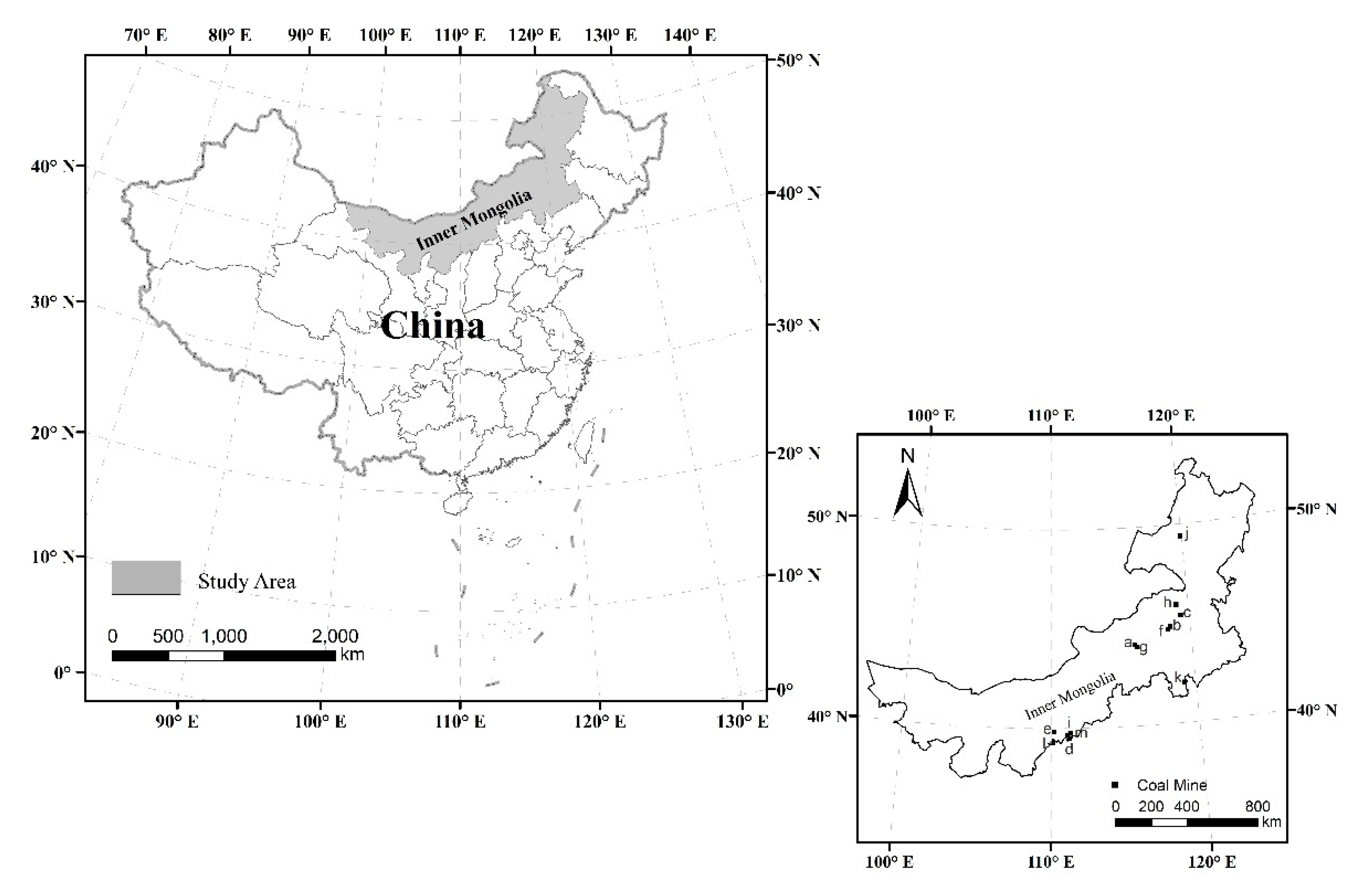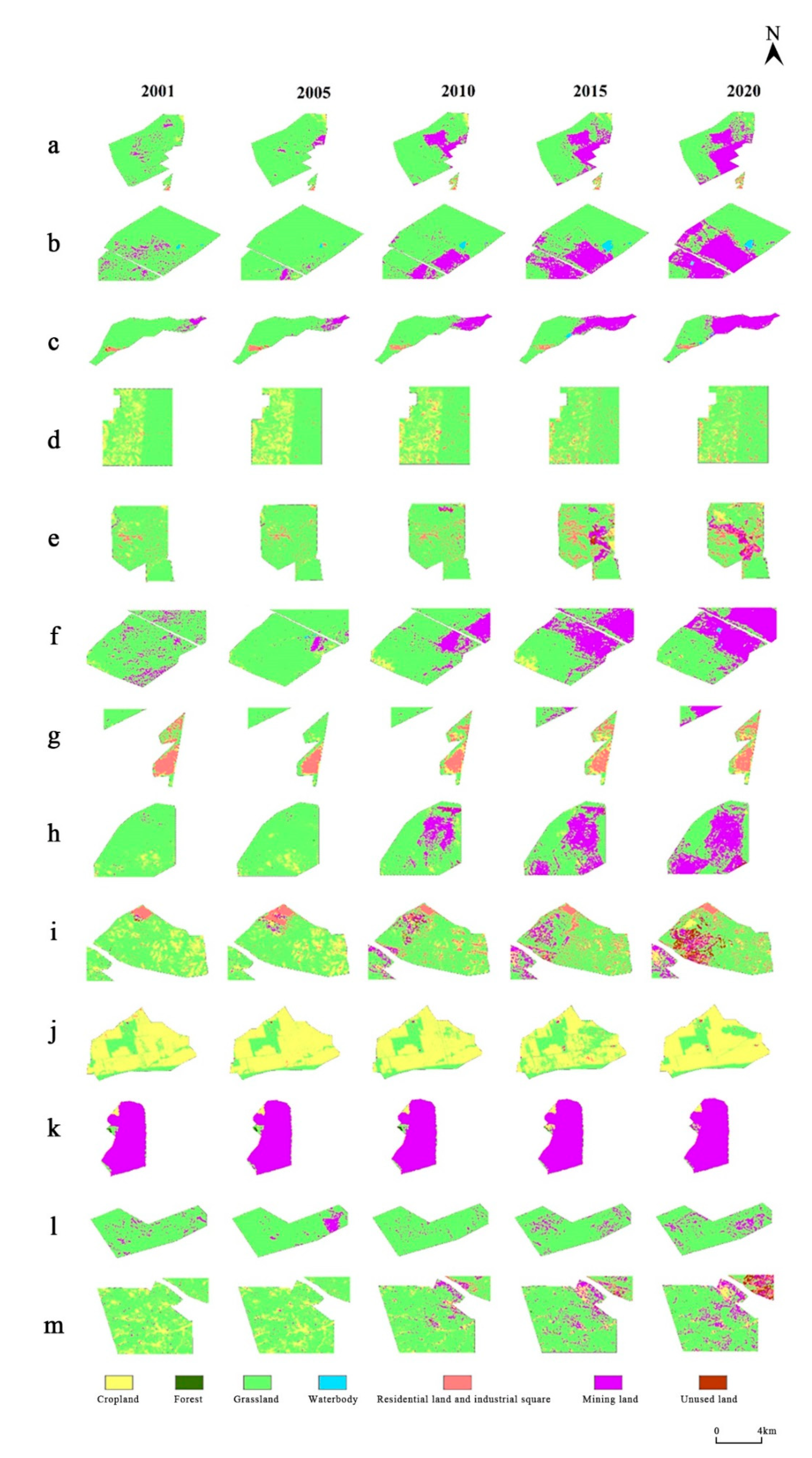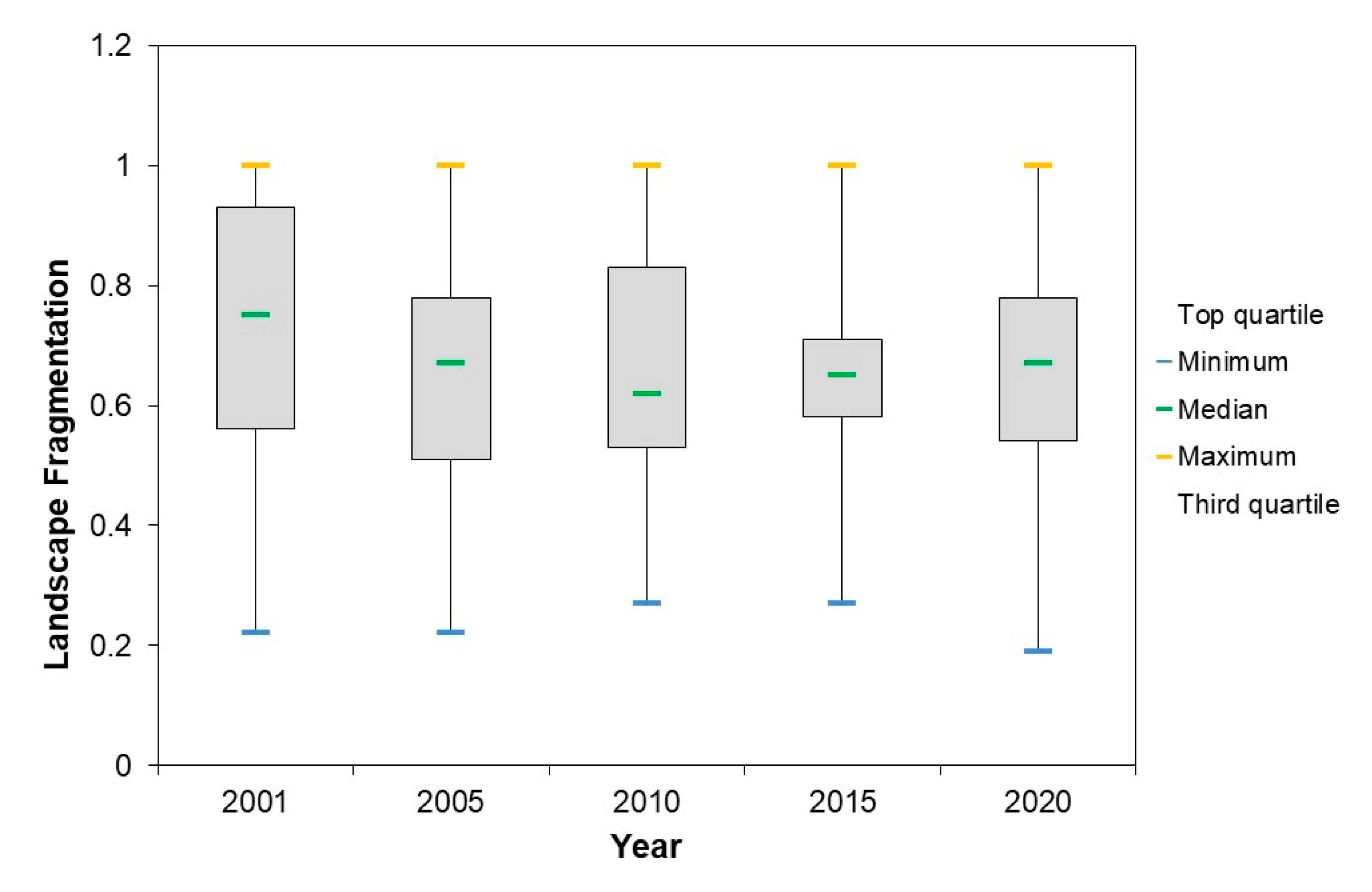The Landscape Pattern Evolution of Typical Open-Pit Coal Mines Based on Land Use in Inner Mongolia of China during 20 Years
Abstract
:1. Introduction
2. Materials and Methods
2.1. Study Area
2.2. Data Sources and Processing
2.3. Study Method
2.3.1. Land-Use Change Analysis
2.3.2. Landscape Pattern Index
- (1)
- Patch density
- (2)
- Landscape division index
- (3)
- Aggregation index
3. Results
3.1. Variation Characteristics of Landscape Types
3.1.1. Quantity Changes of Landscape Types
3.1.2. Spatial Changes of Landscape Types
3.2. Variation Characteristics of Landscape Types
3.3. Ecological Restoration Projects in Opencast Coal Mines
4. Discussion
Author Contributions
Funding
Institutional Review Board Statement
Informed Consent Statement
Data Availability Statement
Conflicts of Interest
References
- Fan, Y.H.; Lu, Z.H.; Cheng, J.L.; Zhou, Z.X.; Wu, G. Major ecological and environmental problems and the ecological reconstruction technologies of the coal mining areas in China. Acta Ecol. Sin. 2003, 10, 2144–2152. [Google Scholar]
- Han, L.Z. Research on Land Use Distribution of Reclaimed Land in Open Pit Mine-Taking the Case of Lu Xin Mine in Heshun County. Master’s Thesis, China University of Geoscience, Beijing, China, 5 June 2016. [Google Scholar]
- Liu, X.C.; Bai, Z.K.; Bao, N.S.; Ma, X. Study on the surface soil resource management of land reclamation in Mongolia Grassland. J. Shanxi Agric. Univ. (Nat. Sci. Educ.) 2010, 30, 253–257. [Google Scholar]
- Wang, J.F. Vegetation and Soil Properties of Ecological Restoration in Typical Open-Pit Mines of Inner Mongolia Grassland Areas. Ph.D. Thesis, Inner Mongolia Agricultural University, Hohhot, China, 12 December 2020. [Google Scholar]
- Technical Guidelines for Plan Environmental Impact Assessment-Coal Industry Mining Area Plan. Available online: https://www.mee.gov.cn/ywgz/fgbz/bz/bzwb/other/pjjsdz/200903/t20090320_135492.shtml (accessed on 16 June 2022).
- Wang, Z.H. Analysis on Desertification of Xing’an League Monitoring Area Based on 3S Technology. Master’s Thesis, Inner Mongolia Agricultural University, Hohhot, China, 9 June 2017. [Google Scholar]
- Suggestions of the Party Committee of Inner Mongolia Autonomous Region on Formulating the Fourteenth Five-Year Plan for National Economic and Social Development and the Long-Term Goals of 2035. Available online: https://www.nmg.gov.cn/zwyw/ldhd/202101/t20210105_407052.html (accessed on 16 June 2022).
- Gao, Y.Z.; Chu, Y.; Liang, W. Remote sensing monitoring and analysis of tailings ponds in the ore concentration area of Heilongjiang Province. Remote Sens. Nat. Resour. 2015, 27, 160–163. [Google Scholar]
- Raval, S.; Shamsoddini, A. A monitoring framework for land use around kaolin mining areas through Landsat TM images. Earth Sci. Inform. 2014, 7, 153–163. [Google Scholar] [CrossRef]
- Resource and Environment Science and Data Center. Available online: http://www.resdc.cn/ (accessed on 24 December 2021).
- China Meteorological Data Sharing Service System. Available online: https://data.cma.cn/ (accessed on 20 November 2021).
- Shi, X.W.; Feng, G.J.; Yi, Y.; Zou, Y.J.; Ge, H.R.; Su, P.T. Temporal and spatial evolution characteristics and ecological risk assessment of land use landscape patterns in central Zhejiang urban agglomeration. Trans. Chin. Soc. Agric. Mach. 2020, 51, 242–251. [Google Scholar]
- Sun, L.; Tang, G.P.; Dou, Y.F.; Liu, Y.L.; Wu, Y.Z. Land use/cover change and underlying driving forces in Dongjiang River basin during 2001-2013. Bull. Soil Water Conserv. 2018, 38, 293–300. [Google Scholar]
- Tian, S.; Luo, G.J.; Liao, J.J.; Luo, X.L.; Wang, Q. Characteristics and driving factors of land use evolution in typical traditional village gathering place. Resour. Environ. Yangtze Basin 2021, 30, 2682–2692. [Google Scholar]
- Wang, Z.C.; Gao, Z.Q. Analysis on spatiotemporal characteristics and causes of tidal flat wetland in Jiaozhou Bay from 1987 to 2017 based on land use change. Res. Soil Water Conserv. 2020, 27, 196–201. [Google Scholar]
- Yin, L.J.; Zhou, Z.F.; Zhu, C.L.; Shang, M.J. Geomorphological differentiation characteristics of land use change in karst rocky desertification area—A case of Guanling-Zhenfeng Huajiang rocky desertification comprehensive demonstration zone in Guizhou Province. Bull. Soil Water Conserv. 2020, 40, 37–46. [Google Scholar]
- Wang, Z.C.; Zhang, K.; Ding, Z.P.; Wu, S.Y.; Huang, C.H. Delineation of urban growth boundary based on improved FLUS model considering dynamic data. J. Geo-Inf. Sci. 2020, 22, 2326–2337. [Google Scholar]
- Diffendorfer, J.E.; Dorning, M.A.; Keen, J.R.; Kramer, L.A.; Taylor, R.V. Geographic context affects the landscape change and fragmentation caused by wind energy facilities. PeerJ 2019, 7, 7129. [Google Scholar] [CrossRef] [PubMed]
- Wu, Z.H.; Lei, S.G.; Lu, Q.Q.; Bian, Z.F. Impacts of large-scale open-pit coal base on the landscape ecological health of semi-arid grasslands. Remote Sens. 2019, 11, 1820. [Google Scholar] [CrossRef] [Green Version]
- Feng, J.M.; Dong, G.F.; Guo, L.X.; Wen, Q. Ecological responses to changing landscape patterns in Yushenfu mining area. Arid Zone Res. 2014, 31, 1141–1146. [Google Scholar]
- Qiu, W.W.; Hou, H.P. Research on landscape disturbance in complex terrain mine area. China Min. Mag. 2013, 22, 50–53. [Google Scholar]
- Fu, G.; Li, J.S.; Qi, Y.; Gao, X.Q.; Xiao, N.W.; Ren, M.Y. An Evaluation Method for Landscape Fragmentation Index. CN108345897A, 31 July 2018. [Google Scholar]
- Wang, Y.F.; Zhao, X.L.; Zuo, L.J.; Zhang, Z.X.; Wang, X.; Yi, L.; Liu, F.; Xu, J.Y. Spatial differentiation of land use and landscape pattern changes in the Beijing–Tianjin–Hebei area. Sustainability 2020, 12, 3040. [Google Scholar] [CrossRef] [Green Version]
- Deng, S.F. Analysis of Landscape Pattern and Ecosystem Service Value in Jiangxi Province under Land Use Change. Master’s Thesis, East China University of Technology, Nanchang, China, 30 June 2021. [Google Scholar]
- Xu, J.X.; Li, G.; Chen, G.L.; Zhao, H.; Qu, J.F. Changes of landscape ecological quality for land reclamation in mining area. Trans. Chin. Soc. Agric. Eng. 2013, 29, 232–239. [Google Scholar]
- Zhang, L.; Song, W.; Song, W. Assessment of Agricultural Drought Risk in the Lancang-Mekong Region, South East Asia. Int. J. Environ. Res. Public Health 2020, 17, 6153. [Google Scholar] [CrossRef] [PubMed]



| Year | Classification Image | Kappa | Overall Accuracy |
|---|---|---|---|
| 2001 | Landsat 5 | 0.931 | 0.962 |
| 2002 | Landsat 5 | 0.937 | 0.966 |
| 2003 | Landsat 5 | 0.939 | 0.966 |
| 2004 | Landsat 5 | 0.933 | 0.963 |
| 2005 | Landsat 5 | 0.935 | 0.964 |
| 2006 | Landsat 5 | 0.926 | 0.956 |
| 2007 | Landsat 5 | 0.932 | 0.963 |
| 2008 | Landsat 5 | 0.931 | 0.965 |
| 2009 | Landsat 5 | 0.945 | 0.970 |
| 2010 | Landsat 5 | 0.943 | 0.969 |
| 2011 | Landsat 5 | 0.943 | 0.969 |
| 2012 | Landsat 7 | 0.944 | 0.969 |
| 2013 | Landsat 7 | 0.933 | 0.965 |
| 2014 | Landsat 8 | 0.954 | 0.975 |
| 2015 | Landsat 8 | 0.953 | 0.974 |
| 2016 | Landsat 8 | 0.934 | 0.964 |
| 2017 | Landsat 8 | 0.950 | 0.973 |
| 2018 | Landsat 8 | 0.938 | 0.966 |
| 2019 | Landsat 8 | 0.937 | 0.966 |
| 2020 | Landsat 8 | 0.934 | 0.964 |
| Year | Land-Use Types | Cropland | Forest | Grassland | Waterbodies | Residential Land and Industrial Squares | Mining Land | Unused Land |
|---|---|---|---|---|---|---|---|---|
| 2001 | Area/km2 | 130.83 | 0.04 | 376.39 | 6.54 | 24.53 | 78.28 | 2.91 |
| 2005 | Area/km2 | 122.80 | 0.04 | 390.52 | 0.96 | 45.41 | 56.91 | 3.16 |
| 2010 | Area/km2 | 112.41 | 0.03 | 376.94 | 0.38 | 44.36 | 79.71 | 6.16 |
| 2015 | Area/km2 | 113.58 | 0.04 | 324.96 | 2.58 | 69.29 | 104.58 | 5.82 |
| 2020 | Area/km2 | 118.82 | 0.05 | 315.11 | 0.89 | 96.28 | 80.03 | 10.18 |
| 2001–2005 | Area variation/km2 | −8.02 | −0.01 | 14.13 | −5.58 | 20.87 | −21.36 | 0.25 |
| Rate of change/% | −6.13 | −12.50 | 3.76 | −85.27 | 85.08 | −27.29 | 8.64 | |
| 2005–2010 | Area variation/km2 | −10.39 | −0.01 | −13.58 | −0.59 | −1.05 | 22.79 | 3.00 |
| Rate of change/% | −8.46 | −33.33 | −3.48 | −61.06 | −2.31 | 40.05 | 94.96 | |
| 2010–2015 | Area variation/km2 | 1.17 | 0.01 | −51.98 | 2.21 | 24.94 | 24.87 | −0.33 |
| Rate of change/% | 1.04 | 53.57 | −13.79 | 587.77 | 56.22 | 31.21 | −5.44 | |
| 2015–2020 | Area variation/km2 | 5.24 | 0.01 | −9.84 | −1.69 | 26.98 | −24.55 | 4.35 |
| Rate of change/% | 4.61 | 20.93 | −3.03 | −65.62 | 38.94 | −23.48 | 74.72 | |
| 2001–2020 | Area variation/km2 | −12.00 | 0.00 | −61.27 | −5.66 | 71.74 | 1.75 | 7.27 |
| Rate of change/% | −9.18 | 8.33 | −16.28 | −86.44 | 292.44 | 2.24 | 249.92 |
| Land Use Types | Cropland | Forest | Grassland | WaterBodies | Residential Land and Industrial Squares | Mining Land | Unused Land |
|---|---|---|---|---|---|---|---|
| Cropland | 85.58 | 0.01 | 37.88 | 0.03 | 6.51 | 0.38 | 0.44 |
| Forest | 0.02 | 0.01 | 0.00 | 0.00 | 0.01 | 0.00 | 0.00 |
| Grassland | 26.07 | 0.03 | 257.35 | 0.68 | 68.58 | 16.19 | 7.49 |
| Waterbodies | 4.80 | 0.00 | 1.54 | 0.12 | 0.07 | 0.01 | 0.01 |
| Residential Land and Industrial Squares | 1.95 | 0.00 | 5.47 | 0.01 | 14.66 | 1.63 | 0.22 |
| Mining land | 0.17 | 0.00 | 12.02 | 0.05 | 3.96 | 60.49 | 1.59 |
| Unused land | 0.23 | 0.00 | 0.86 | 0.00 | 0.06 | 1.32 | 0.43 |
| Mining Area Code | Year | ||||
|---|---|---|---|---|---|
| 2001 | 2005 | 2010 | 2015 | 2020 | |
| a | 0.58 | 0.52 | 0.65 | 0.63 | 0.65 |
| b | 0.56 | 0.53 | 0.52 | 0.58 | 0.49 |
| c | 0.51 | 0.48 | 0.53 | 0.42 | 0.48 |
| d | 1.00 | 1.00 | 1.00 | 1.00 | 1.00 |
| e | 0.94 | 0.76 | 0.59 | 0.43 | 0.70 |
| f | 0.72 | 0.67 | 0.62 | 0.65 | 0.54 |
| g | 0.78 | 0.89 | 0.83 | 0.75 | 0.78 |
| h | 0.55 | 0.27 | 0.46 | 0.59 | 0.67 |
| i | 0.93 | 0.83 | 0.85 | 0.70 | 0.77 |
| j | 0.22 | 0.22 | 0.27 | 0.27 | 0.19 |
| k | 0.75 | 0.51 | 0.59 | 0.71 | 0.64 |
| l | 0.85 | 0.72 | 0.78 | 0.67 | 0.79 |
| m | 0.97 | 0.78 | 0.89 | 0.90 | 0.84 |
Publisher’s Note: MDPI stays neutral with regard to jurisdictional claims in published maps and institutional affiliations. |
© 2022 by the authors. Licensee MDPI, Basel, Switzerland. This article is an open access article distributed under the terms and conditions of the Creative Commons Attribution (CC BY) license (https://creativecommons.org/licenses/by/4.0/).
Share and Cite
Zhang, L.; Zhai, Z.; Zhou, Y.; Liu, S.; Wang, L. The Landscape Pattern Evolution of Typical Open-Pit Coal Mines Based on Land Use in Inner Mongolia of China during 20 Years. Sustainability 2022, 14, 9590. https://doi.org/10.3390/su14159590
Zhang L, Zhai Z, Zhou Y, Liu S, Wang L. The Landscape Pattern Evolution of Typical Open-Pit Coal Mines Based on Land Use in Inner Mongolia of China during 20 Years. Sustainability. 2022; 14(15):9590. https://doi.org/10.3390/su14159590
Chicago/Turabian StyleZhang, Lijia, Zihan Zhai, Yan Zhou, Shihan Liu, and Liwei Wang. 2022. "The Landscape Pattern Evolution of Typical Open-Pit Coal Mines Based on Land Use in Inner Mongolia of China during 20 Years" Sustainability 14, no. 15: 9590. https://doi.org/10.3390/su14159590
APA StyleZhang, L., Zhai, Z., Zhou, Y., Liu, S., & Wang, L. (2022). The Landscape Pattern Evolution of Typical Open-Pit Coal Mines Based on Land Use in Inner Mongolia of China during 20 Years. Sustainability, 14(15), 9590. https://doi.org/10.3390/su14159590





